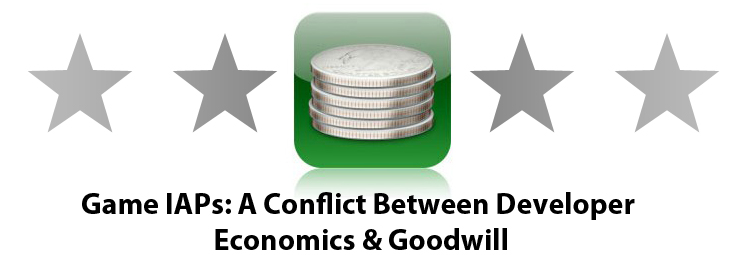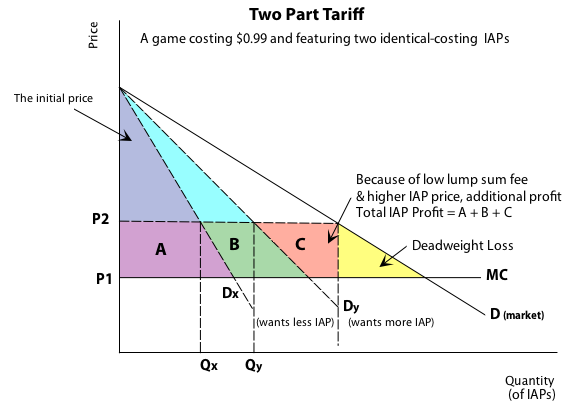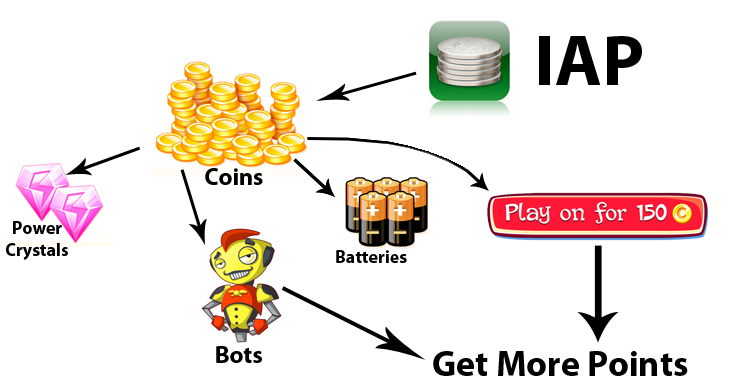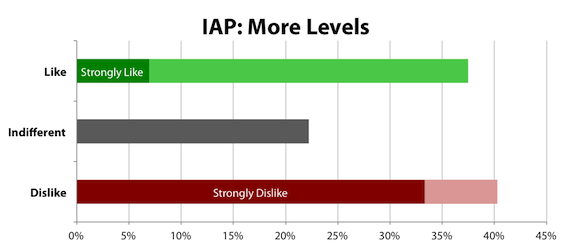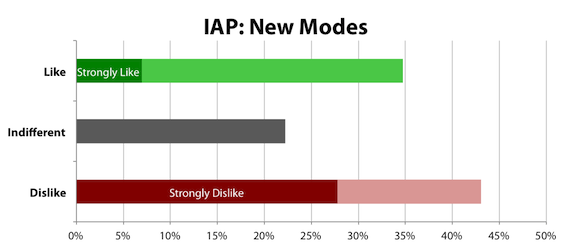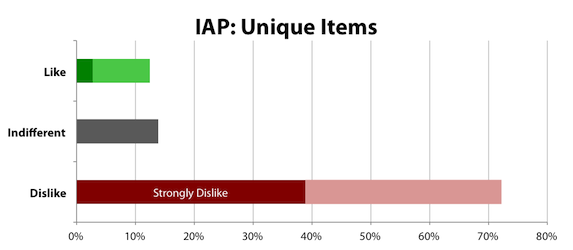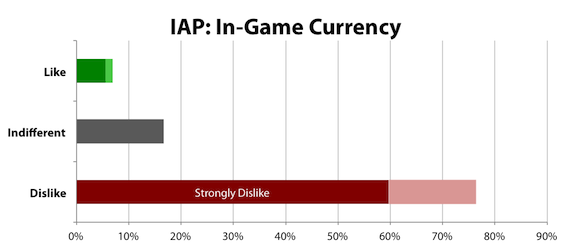In-App Purchases for iOS games. It’s a bit of a sensitive topic really, not many people like them at all, and quite a few people hate them and the impact they have had on the iOS games market. But today I want to explore the reason for their prevalence and explain why it has become an important part of the market for developers. I also want to reframe the discussion from one of “In-App Purchases are a problem” to one where we consider how they are being used and what developers could do to improve their implementation.
Below the break is Part 1: The Economics, in which I tackle the reason for their prevalence and importance in the iOS games market. Following that is Part 2: “Developers and Goodwill To Customers” in which I discuss how they are being used and perhaps what might be some best practices.
Economic Section
The App Store Gold Mine
The App Store is often portrayed as a gold mine of opportunity for developers, but this is a bit of a facade in reality. There are a lot of App Store success stories and whilst I don’t mean to discount them, one needs to remember that there are around 600,000 apps available on the iOS App Store - so whilst they are impressive, they certainly aren’t representative. In fact doing some very rough maths to get a general picture of the situation, let’s assume that 300,000 apps are paid or have In-App Purchases (I think this is an underestimation) and that the $4 billion that Apple has given to developers as of January 2012 was spread evenly across them all. How much would each app have earnt? Only about $13,500. That certainly isn’t enough for developers to make a living — and in reality we know that app earnings are likely positively (right) skewed in which most apps will earn very little, and a smaller proportion will earn very large amounts (the Angry Birds, Fruit Ninjas and Tweetbots of the App Store world).
The (Very) Competitive iOS Games Landscape
Now, looking at just the game landscape of the App Store, one can see that it is an incredibly competitive one. If you were to place the market in between a perfectly competitive market and a monopoly, it would surely be far closer to the former. This is evident from the number of sellers (a lot), low barrier to entry and lack of market power that any one seller in the market has. That last point is particularly salient here, because if an App Store game is sold, it is almost always $0.99 or very close to that. It takes a very unique game to be priced at a higher level and actually sell.
Pricing Strategies of iOS Game Developers
So what can developers do when developing a price strategy for their iOS game? Generally, here are five broad options:
- Charge a few dollars — game has to be quite unique or differentiated in some way to succeed at this price.
- Price at or close to $0.99 — it’ll be a struggle to make the game stand out from the flood of other cheap games, but at least price isn’t much of a barrier to new customers.
- Price at or close to $0.99 — same as above, but also use In-App Purchases to bolster revenue.
- Go free — again, it’ll be a struggle to make the game stand out from the (even larger) flood of free games, but price is no longer a barrier to customers. Use adverts in game and hope you get enough players (that stick around) to get enough ad revenue to sustain you.
- Go free — see above. But rather than (or in addition) to adverts, use In-App Purchases for revenue.
Unsurprisingly the first option is the least used in the App Store for games — it is reserved for almost entirely high profile games that have console companions, games by big name developers who can afford to heavily market it and for a few high calibre indie games (Sword & Sworcery is one that comes to mind). The remaining three are all very prevalent, but today I’m focusing on those with In-App Purchases.
The Prevalence of In App Purchases
To a degree, In-App Purchases are a controversial topic as I will discuss later on, and it seems fairly evident that they are more prevalent in App Store Games than general apps. To double check on this subconscious observation, I had a quick look at the Top Paid and Top Free lists in the App Store and separated the top 15 games and top 15 apps. I then checked how many of each used IAPs and the result was pretty clear:
- Top 15 Games: 53% (Paid), 60% (Free)
- Top 15 Apps: 33% (Paid), 20% (Free)
Whilst admittedly that is only a small sample on a particular day, there (as far as I know) isn’t really a simple way to survey a larger number without spending a long time manually checking apps one at a time. Further, I am fairly certain that the general ratio would be the same - but if you have evidence to the contrary, please let me know.
So can we explain this phenomenon in the context of the iOS Games market, or do game developers just think that IAPs make their games better? The former is my answer — and for a few key reasons. The big one is that, for many developers, it simply isn’t sustainable to sell a game at or close $0.99, let alone giving it away for free (even with adverts inside). They need an alternative source of income for it to be sustainable, IAPs is a tool that hopefully lets them do that. The second (related) reason is that by ‘splitting’ the cost of the app into an upfront cost (zero in the case of ‘free’ apps) and a (potential) future IAP, they have lowered the entry cost for customers, increasing their potential user base. This can be an incredibly important opportunity as Draw Something recently showed.
Price Discrimination
Microeconomics provides us with the theory of price discrimination — we can use it to explain what IAPs are permitting and the impact it has on consumers, developers, and the market as a whole. Simply, price discrimination allows a firm (developer) to charge different prices to different consumers for a good or service. There are a few different forms of price discrimination, but the one appropriate here is something called a two-part tariff: in this form of price discrimination the firm charges a lump sum and then a per-unit charge. You may be familiar with this at theme parks where you pay an entry fee (the lump sum) and then for rides inside the park (the per-unit charge) or perhaps a credit card that has an annual fee (the lump sum) and then a per-transaction fee (the per-unit charge).
Applying it to games, the two-part tariff works in that you pay a lump sum fee to buy the app and then the IAPs are the per-unit charges. As explained earlier, because the (entry) price of the app has been lowered, a greater quantity can be sold (the law of demand). But there is a benefit to the developer with the introduction of IAPs, because now they can “discriminate” between their customers. Those who are willing to spend more, will spend money on those IAPs and that additional revenue will go toward the developer. Economists call this phenomenon of price discrimination the “extraction of consumer surplus*” — by being able to charge different prices, they can get that additional benefit that the consumer would have got if the developer didn’t offer the IAP.
*Consumer Surplus is a term used to describe the additional benefit a consumer got from consuming a good at a price less than they were willing to pay. Because the developer can price discriminate, that difference will be much smaller.
Note: If there are any economists amongst our readers, I would love to hear your thoughts about this (graham [at]macstories.net). Whilst I am fairly confident of my general interpretation & application of the two-part tariff, I am not 100% certain that the diagram is appropriately designed for the market I am speaking of.
Inelastic Demand
Before I wrap up the economics side of this discussion, I should point out an increasingly common thread in mobile (and social) game design. It’s the use of many psychological ‘tools’ such as appointment gaming in order to compel users to keep coming back to the game — simply, the developers want it to effectively become an addiction. Developers can then target users with IAPs more effectively.
For those unfamiliar with the concept of elasticity of demand, it’s all about how responsive demand is to a change in price (in other words, if price was to increase by 10%, how much would quantity change). An inelastic good is one that isn’t very responsive to a change in price (quantity will change by a lesser percentage than price does). Classic examples of inelastic goods are needs and addictive substances (e.g. cigarettes). The whole point of this is that if developers are able to hook users and get them addicted to the game, those consumers will be more willing purchase IAPs (which if you recall, are optional per-unit charges, as per the two-part tariff).
Connecting the Dots (A Summary)
If we could go back to day one of the App Store and compare the iOS landscape to what it is today we would find quite a striking difference. The market has matured and expanded substantially, to the point where it is close to a perfectly competitive market. This reality has meant that prices have fallen significantly to where most apps are now free or on the lowest pricing tier of $0.99. To make these kind of prices sustainable, a number of different pricing strategies have emerged - IAPs are playing a big part in the strategy for many developers, allowing them to discount the initial entry cost of the app and then make up for it in later IAPs. This is somewhat of a classic form of price discrimination, specifically a two-part tariff, allowing developers to charge different prices to different consumers and hopefully extract the maximum amount of surplus from the consumer and transfer it to the developer at a later stage through IAPs. To maximise the willingness of consumers to pay for these IAPs, another strategy sometimes comes into play — the idea of designing games to increase their addictiveness and thus make demand inelastic. Inelastic demand will mean consumers will be more willing to consume those IAPs.
Developers and Good Will To Customers
Introduction: The Conflict
When In-App Purchasing was introduced, a lot of people were afraid that it would complicate the whole App Store and take away from the simplicity that Apple prides itself on. Whilst that sentiment has largely dissipated, there was also the concern that it would be used by developers in a way that would frustrate consumers by making them pay for what would seem like core features that should have been included in the price of admission — this sentiment has not faded. Before I even started thinking about this article, it was clear to me that a lot of people had issues with IAPs - and whilst I never personally had strong feelings against them, I still checked for IAPs before purchasing a lot of games. As I have hopefully conveyed above, IAPs are, for a lot of developers, not a choice but a necessity given the intensely competitive nature of the iOS Games market. Whilst I am sure some consumers would prefer IAPs to not exist, they do and many developers need them — so is there anything we can do about this conflict, and if so how can it be resolved?
The Genesis of this Article
Before I talk more about whether the conflict can be resolved, I want to talk about how this article came about, as it raises a number of salient points about that conflict that are worth discussion first. It effectively came about because of my disappointment of Flight Control: Rocket when I purchased it and played it a few months ago now. I had liked the original but wasn’t a huge fan, but I bought FC:R because I had just got the new iPad and saw that FC:R supported the Retina Display. When I first played it, I was extremely impressed with it — the visual style is stunning (particularly so on the new iPad) and I preferred the faster pace of the game. Unfortunately I slowly came to realise that FC:R was a much more complicated game than the original Flight Control.
I presume most of you are aware of how to play Flight Control - you have to land the airplanes and helicopters on the appropriate runway/helipad by drawing the flight path from plane to landing strip — the game ends when you have a collision, so the goal is to land as many planes/helicopters as possible. FC:R has the same essential premise, but the gameplay is quite different because of a lot of added tools/features, so let me try to explain it all:
- Unlike the original where the focus was on the number of planes landed, in FC:R, it’s all about the number of points you get.
- Randomly, coins (note: these are different to points) will spawn and fly in to the game, tapping on them gives you a certain number of coins.
- You get 3 “lives” — meaning the game ends after your third crash, unlike the original which ended after any crash. But, you can continue playing if you pay up a certain number of coins.
- Before you start playing you get to equip some bots and a power crystal. It costs coins to “open” the slots for the bots (there are three slots) and you must also purchase bots with your coins.
- If you equip a power crystal, it will triple the experience your bots earn (they get more powerful as they level up with that experience) — but the power crystals must be bought with coins and do deplete over time.
- Your bots can also become inactive if they don’t have enough energy — so you either have to wait for them to charge up by themselves (takes time) or you can purchase some batteries to instantly recharge them (they cost coins).
- You can buy coins through in-app purchases ranging from $0.99 which gets you $2,000 coins (enough for 5 batteries) to $51.99 which gets you 1,000,001 coins (enough for all the bots and hundreds of batteries and coins).
As you can imagine, as I played FC:R and slowly discovered all of the above complications, I become progressively sad at what the game had become. It also explained some of my confusion during the early stages of playing the game - I didn’t understand what bots were and what purpose they had. When I did connect the dots, it became clear that coins were the backbone of the game, and of course you get coins by either playing a lot or by purchasing IAPs. In the end I slowly tapered off my play of the game and I probably played it less than the original game — not because of some kind of moral stand against IAPs, but because the game just became less fun as I kept playing, knowing that it wasn’t really about the number of rockets I landed or points I got. No, it was about getting coins — without them I wouldn’t be getting more bots or power crystals or get more lives. It felt like the use of IAPs had corrupted the game.
From there I decided to reach out to you, our readers, and ask for your opinion on IAPs in games. I wanted to get more of a perspective on the issue, and see if people really did dislike IAPs. I was also hesitant to write an opinion piece that purely focused on Flight Control: Rocket because I actually like the developer, Firemint. In addition to making Flight Control they also make Real Racing (one of my favourite iOS games) and Spy Mouse (I also liked it) and were one of the very first game developers that truly innovated with the arrival of the iPhone. My suspicion (pure speculation) is that after being acquired by EA in May of 2011 they faced high revenue targets and were forced to do something drastic with FC:R and effectively designed the game to encourage the use of IAPs.
The Survey: A Mixed Response
To really get a picture of what people thought about IAPs I decided to make a short survey asking for comments on IAPs, good examples, bad examples and what you would say to a developer considering implementing IAPs. I want to share some of those comments now, because they were of a great calibre and helped a lot when I was preparing this piece.
You could pretty much categorise all the comments into “mildly positive”, “mixed” and “strongly negative”. Starting with the “mildly positive”, they frequently covered the fact that they didn’t think it affected them much, that it’s a way to say thanks to the developer or that it was often implemented in a “try before you buy” way. Here’s one such response:
“I think game IAP are, in most cases, totally optional and thus have very little influence on the overall experience. …Those who only want to play “casually” will be able to do so without needing to pay anything if the basic game is free, or for a fair amount of money. Instead, die-hard fans of the game will be able to get “plus” items (by paying extra) but they’ll be totally fine with it since they actually, really want to have them (there’s no forcing).” [Anonymous]
Then we had quite a few mixed responses including these two highlights:
“Its been a so-so experience, some do it well and non-intrusively while others don’t. Generally it has changed gaming to feel more money-centered than gaming experience-centered. (This will sound weird but) If the game is well-executed, I feel it gives the user an opportunity to thank the dev while getting a thank you gift in return.” [Anonymous]
“I gladly pay a dollar or two for additional levels if I’m enjoying the game. I have never and will never buy power-ups or in-app currency. I would sooner delete the game. I think game developers are doing themselves a huge disservice by poorly implementing IAP for things like that.” [Mike Beasley @mikebeas]
Then there was the negative, and if I was to summarise their sentiments it would be that they felt “nickel and dimed” by IAPs - that phrase came up a surprising number of times. But here are some excerpts of my favourite responses:
“IAP has been detrimental to iOS gaming. A lot of developers seem to think it is acceptable to offer *very* limited games with adverts, and use IAP to remove the adverts/extend the game.” [IscariotJ]
“Driving crappy development. Make real products for sale and maintain a real review system.” [@FredTheBishop]
“I shudder to think what Plants vs. Zombies would look like if it were first offered in 2012” [@nanaslugdiva]
“I think it is sort of bait-and-switch. I am pretty picky when it comes to games I choose to spend my time on, so if a game has in-app purchases I tend to just assume the game mechanics is based on it and tend not to download/buy the app.” [Joel Irwin @irwindigital]
“Developers now strive for gameplay mechanics that can be attatched to IAPs. Well not all, but I think it’s increasing. I always think twice if I want to buy an app which contains IAP. And if I have to make an IAP to be able to use most of the features, I am done with that app”. [@jrryror]
People’s Opinions on Varying Forms of IAP
Something I wanted to see when asking for people’s opinions on game IAPs were which implementations were most acceptable to them and which they despised. I selected some of the most common forms and asked the respondents to choose one of the following; Strongly Dislike, Dislike, Indifferent, Like, Strongly Like. The results were pretty negative for all the options, but that didn’t stop there from being a clear distinction between the different implementations. I’ll let the graphs do most of the talking, but in short, the least hated were IAP implementations that gave the user more levels or new modes/capabilities. On the other hand, IAPs that give you in-game currency was detested as well as those that let you level up quicker. IAPs that give you more game tools (such as a unique gun) sat in-between the two extremes, but really wasn’t liked much at all.
The results were pretty much what I expected and they confirmed my feelings that people don’t appreciate (that might be putting it lightly) when developers implement a paid “cheating” system where you can bribe the game (with real money) into giving you some virtual advantage within the game. This may seem to conflict with the reality that a number of Zynga games such as Farmville are incredible hits with millions of people parting with their money to get exactly that “bribe”. That’s where we come back to the economics side of this and the discussion of how games like Farmville have been designed to be incredibly addictive. Making it addictive wasn’t accidental either - just read this response on Quora by Farmville co-creator Sizhao Zao Yang in which he outlines the various strategies and tools they used to achieve that. Because it is addictive, demand becomes more inelastic and that leads consumers to be less responsive to the price of the good — hence why in-game currency IAPs can work so well for Farmville-esque games.
On the other hand, people are much more appreciative of paying for something that is more tangible — like more levels or new game modes. They are more substantial than a new gun, or some in-game coins that can buy you a power-up. I think this feeling is amplified when a user moves on from a game and looks back at what they payed for. If they were just buying currency for power-ups, there really isn’t anything to show for that money that they once spent. On the other hand if they bought a new game mode, they can see that additional mode and if they decide to come back to the game at a later date, they’ll still have that and be able to take advantage of it.
A Best Practice Guide for Developers?
So armed with all the information we’ve learnt along this journey, can we set out some sort of best practice guide for iOS game developers if they decide to go down the IAP route and want to establish a relationship of goodwill with their customers? I think it obviously depends on a case by case basis, but I think there are some guiding principles to take note of and a few things to avoid as much as possible.
The biggest no-no from my interpretation of all the data and observations is to stay far away from making your game revolve around IAPs. What I mean by this is that gameplay mechanics are being driven by the goal of maximising IAPs - I think this is why people despise IAPs for in-game currency, because it feels they are being nickel and dimed all the time. This doesn’t mean that you should never use in-game currency, because there were a few survey respondents who appreciated Tiny Towers’ implementation. Many users felt as though it wasn’t as forcefully implemented and was a purely optional choice. But on the whole, IAPs should not be driving the development of the rest of the game, as this excellent comment conveyed:
“Design a game to be enjoyable and fun, then price it right. If you tune your game mechanics to maximise IAP revenue, all you do is create frustration, you hate your customers”. [Hilton Lipschitz @hiltmon]
A second point that was very frequently mentioned in the “comments to a developer” section of the survey was to make the game complete (and satisfying), without having to buy additional levels/modes. But once that criteria has been met, more levels or modes is perfectly fine - Carcassone (new game mode with an IAP) and Scribblenauts (more levels with an IAP) were frequently cited as examples of this being done successfully. It’s a balancing act that should be carefully considered by the developer.
Keep it simple and limit the number of IAPs you offer. Constantly barraging the user with IAPs further amplifies the nick and diming sentiment. Each additional IAP that is offered devalues the current worth of the game and those IAPs - well users may feel like they just aren’t worth it.
Finally, I couldn’t pass up this comment by an actual developer, riffing on the idea behind price discrimination and balancing it with ensuring there is a goodwill relationship between him and his customers. (Emphasis is mine)
“Use IAP to give interested users a chance to get more out of the app. Offer additional levels or characters, but always consider that users who don’t want to invest more money in the app are still your users. Respect them! Don’t make them feel like they’re not worthy of playing cool characters, because they only get a crap one from you.” [Fabian Kreiser @fabiankr]
Conclusion
My hope at the end of this discussion is that I’ve explained some of the economics behind iOS games and why In-App Purchases are so prevalent and why they won’t be going away anytime soon. Beyond that, I hope that thanks to the survey and other observations, I’ve highlighted the specific implementations of IAPs that are most straining on the relationship between developers and consumers. The purpose of the best practice guide above wasn’t for profit maximisation (for that, focus on making demand inelastic and offer lots of IAPs), but a balance so that by using IAP and the price discrimination theory, developers can earn more but implement the IAP in a way that is least offensive to consumers. There will always be people who dislike IAP and a number of the survey respondents fit inside that category, but as I explained earlier, that is a wholly unrealistic position for the iOS games market to me. Rather, developers and the wider iOS community should be discussing ways that IAPs can be better implemented in games for a better experience.
Just like Apple, the iOS developer community has been a fountain of innovation and that innovation should also be directed at better IAP implementations. Simply using it to buy in-game currency for power-ups seems like an entirely boring and forced implementation that consumers dislike. Let’s see developers being thoughtful and creative about IAPs, because those that do will be rewarded by customer loyalty and the benefit of those IAPs not only being bought, but bought happily.
A huge thanks to all those who completed the survey I circulated, without your help this article probably wouldn’t have ever seen the light of day. I wish I could have quoted more of your excellent comments, but please know that they were all greatly appreciated and invaluable to me.


